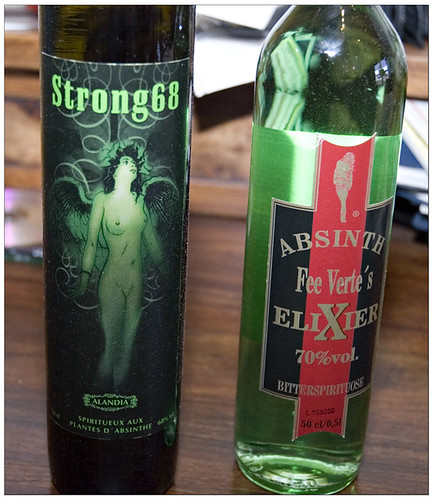
ahhh, Absinthe, why do you tempt me so? All of the opportunities to imbibe your nectar have left me with little more than a sweetly delirious hangover, and yet...
We've discussed absinthe before, even requested a sample bottle from the new absinthe sellers (who cruelly ignored us), yet our mighty thirst has not yet been quenched.Dear reader! Should this column impress you as being more than usually lyrical, recalling perhaps the imagery and elegance of poetry by Baudelaire or Verlaine; should it seem a bit decadent, redolent of Oscar Wilde’s withering hauteur; should it have a touch of madness or perversity, combining, say, the tastes of Toulouse-Lautrec with the passions of van Gogh; should it simply sound direct and forceful and knowing like one of Ernest Hemingway’s characters; should it do any or all of that, let me credit something that each of these figures fervently paid tribute to: the green fairy, the green goddess, the green muse, the glaucous witch, the queen of poisons.
[snip]
Last spring a French brand, Lucid, made its debut here, using 19th-century distilling methods and replicating chemical analyses of pre-ban absinthe. A Swiss absinthe, Kübler. appeared on the American market a few weeks ago, using a 1863 family formula.
One reason legal barriers have fallen is that, as The New Yorker reported in 2006, the regulated chemical thujone, found in wormwood and once thought to have been the cause of absinthe’s lure and its dangers, did not show up in any significant quantities in analyses of historical absinthe. So these authentic replicas, despite containing wormwood, do not pose a legal challenge. And the alarmed pronouncements about absinthe made from the beginning of the Belle Époque have been proved groundless, which was decisive, a Kübler spokesman said, in swaying United States government regulators.
[From Connections - Absinthe - Column - New York Times]
Emulating Spalding Gray, always a dangerous task fraught with danger, I'm simply searching for a perfect moment, a singular experience of transcendence. One's life, in retrospect, is a litany of perfect moments, or their contrary.
More on the topic, to wet your appetite, so to speak:
"Hideous Absinthe: A History of the Devil in a Bottle" (Jad Adams)

"Absinthe: History in a Bottle" (Barnaby Conrad)

"Absinthe: History in a Bottle" (Barnaby Conrad)
Toulouse-Lautrec was so wedded to absinthe that he had a special cane made that hid a glass. He may have also introduced the drink to van Gogh, who threw himself into it with abandon. Aside from drinking the liquor, van Gogh painted it, and once threw a glass of it at Gauguin. Manet and Degas painted absinthe drinkers. So did Picasso. Munch drank it heavily and Strindberg fed his insanity with it. Verlaine felt enslaved to what he called “the green and terrible drink.”I actually can see the relation between absinthe and impressionism. From my limited experience with absinthe intoxication, light descends upon one's eye in discrete packets of colors. I tried to take a photo which emulated this alteration, but it is only a faint approximation of the sensation of absinthe inebriation.
[snip]
Absinthe’s effects suggested, it seems, an inherent instability to perception, as if mixing and distilling the shimmer of Impressionism, the nightmares of Expressionism and the skewed images of Surrealism. Van Gogh made a glass of absinthe vibrate with energy. And when Manet, Degas or Picasso painted absinthe drinkers, they appeared introspective, alienated, not because they have been drugged into oblivion, but because they have seen too much.
At least in imagery, then, absinthe reflected a certain view of modernity: A firm, reliable order weakens, giving way to bleak uncertainties. For some this was a danger. A children’s anti-absinthe poem taught that the drink undermined “love of country, courage and honor.” During the Dreyfus Affair in France in the 1890s, when the French right considered Jews a threat to the old order, absinthe was denounced as a “tool of the Jews.”
